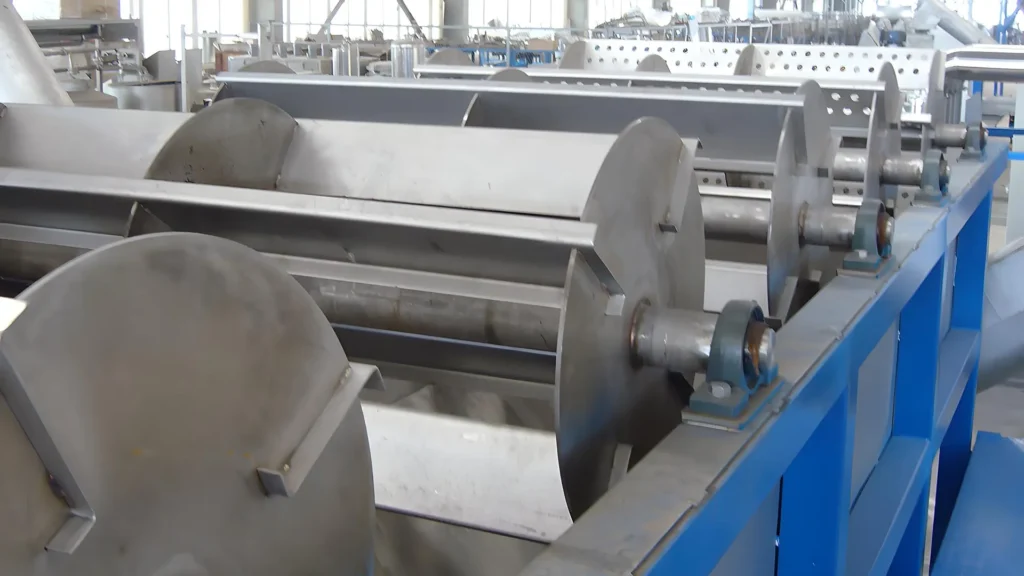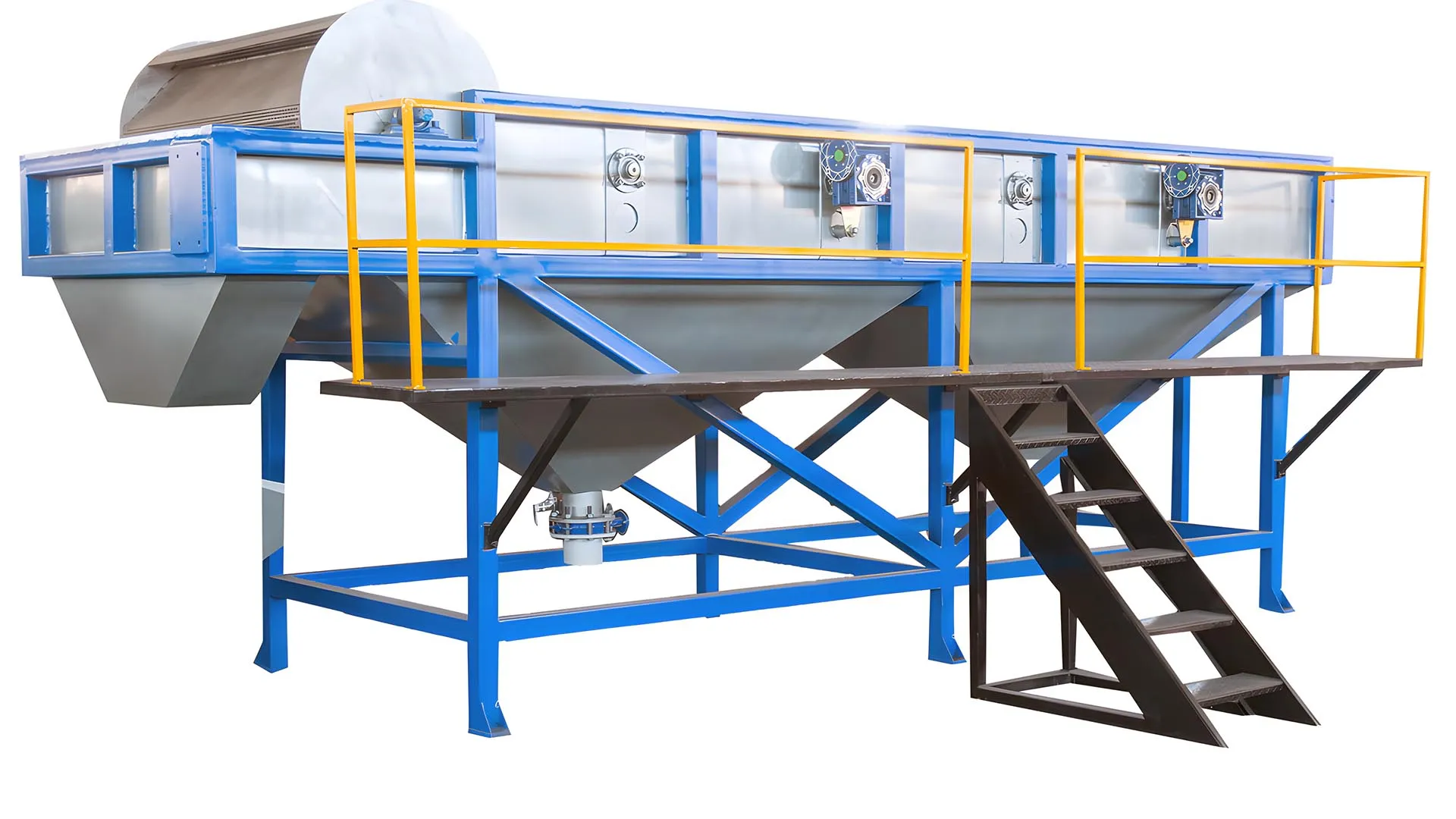No mundo da reciclagem de plásticos, a separação precisa e eficiente dos diferentes tipos de polímeros é fundamental. Tanque de separação flutuante se destaca como uma tecnologia fundamental neste processo crítico. Esta máquina essencial utiliza o princípio simples, porém brilhante, da densidade da água para segregar com maestria materiais como polipropileno (PP) e polietileno (PE) de um fluxo de plástico misto. Dessa forma, não apenas garante a alta pureza dos plásticos separados, como também realiza uma limpeza preliminar, preparando os materiais para a próxima etapa de reciclagem. Vamos explorar a mecânica deste sistema indispensável e entender por que ele é fundamental para a reciclagem moderna e eficaz de plásticos.
O papel crítico do tanque de separação flutuante
Com o crescimento da demanda global por soluções sustentáveis, a necessidade por processos de reciclagem de plásticos altamente eficientes nunca foi tão urgente. O Tanque de Separação Flutuante aborda diretamente um desafio fundamental da indústria: separar plásticos com características visuais e físicas muito semelhantes. Considerando que PP e PE são dois dos plásticos mais abundantes em bens de consumo e industriais, desde filmes para embalagens até peças automotivas, sua recuperação e reciclagem bem-sucedidas têm imensa importância econômica e ambiental. Alcançar um fluxo puro de PP e PE é o primeiro passo para a produção de pellets reciclados de alta qualidade que podem ser reintroduzidos na indústria.
Como funciona o tanque de separação flutuante?
O Princípio da Separação Baseada na Densidade
O princípio operacional do tanque de separação flutuante é elegante em sua simplicidade, mas poderoso em sua aplicação. Tudo se resume à densidade. A água tem uma densidade de aproximadamente 1 g/cm³. O sistema utiliza essa constante para distinguir entre diferentes materiais no fluxo de flocos plásticos de entrada.
- Frações Afundantes (Plásticos Pesados): Materiais com densidade maior que a da água, como Polietileno Tereftalato (PET), Policloreto de Vinila (PVC) e Acrilonitrila Butadieno Estireno (ABS), irão para o fundo do tanque. Essa fração também inclui contaminantes não plásticos, como sujeira, pedras, vidro e fragmentos de metal, que são removidos com eficácia.
- Frações Flutuantes (Plásticos Leves): Por outro lado, os plásticos PP e PE, com densidades inferiores a 1 g/cm³, flutuam na superfície da água. Pás giratórias na superfície guiam suavemente esse material flutuante em direção a uma esteira de descarga, completando a separação.
Visualizando o fluxo de trabalho
Para melhor ilustrar o processo, aqui está um diagrama simples da jornada dos materiais dentro do Tanque de Separação Flutuante:
Fluxo de processo do tanque de separação flutuante
Etapa 1: Alimentação
Flocos de plástico misturados entram no tanque por meio de um transportador helicoidal.
⬇
Etapa 2: Agitação e Separação
Plásticos entram na água. Frações pesadas (PET, PVC, etc.) afundam. Frações leves (PP, PE) flutuam.
⬇
Etapa 3: Coleta
Pás giratórias movem o PP/PE flutuante para uma esteira de saída. Os materiais que afundam são removidos do fundo por uma esteira separada.
⬇
Etapa 4: Descarga
Fluxos separados de PP/PE limpo e frações pesadas são descarregados para processamento posterior.
Inovações de design para desempenho aprimorado
O Tanque de Separação Flutuante recém-redesenhado da Energycle incorpora recursos avançados para aumentar a eficiência da lavagem e promover a conservação da água. Uma inovação fundamental é o exclusivo fundo de sedimentação em formato de "W". Este design inteligente divide o tanque de forma eficaz, criando zonas distintas para processamento:
- Zona de Separação Primária: O fluxo de matéria-prima misturada é introduzido aqui. Esta seção foi projetada para lidar com a maior parte da contaminação, permitindo que sujeira e detritos pesados se depositem rapidamente. A água nesta seção pode ser filtrada e trocada com mais frequência para manter a eficácia.
- Zona de polimento secundária: O plástico flutuante, relativamente limpo, passa então para a segunda metade do tanque. Lá, ocorre a separação e a limpeza finais, resultando em água muito mais limpa, garantindo um produto final com maior pureza e um consumo geral de água significativamente menor.
Especificações técnicas
A escolha do Tanque de Separação Flutuante ideal exige uma análise atenta das especificações técnicas para garantir a adequação perfeita às suas necessidades operacionais. Abaixo, apresentamos as especificações padrão dos nossos modelos:
| Recurso | Especificação |
|---|---|
| Largura interna | 1000 mm – 1800 mm |
| Comprimento total | 4 – 7 metros |
| Material interior | Aço inoxidável tipo 304 (para resistência à corrosão) |
| Estrutura externa | Aço carbono de alta resistência (para integridade estrutural) |
| Motores de pás | 1,5 kW*2 (com controle de frequência para velocidade ajustável) |
| Certificação | Certificação CE disponível |
Observação: entendemos que cada linha de reciclagem é única. Modelos personalizados, maiores e mais potentes, podem ser projetados de acordo com suas necessidades específicas, oferecendo total flexibilidade para atender a diferentes tipos de materiais e demandas de produtividade.

Conclusão: Um investimento essencial para uma reciclagem de qualidade
O Tanque de Separação Flutuante é muito mais do que um simples banho; é uma máquina sofisticada e indispensável em qualquer operação séria de reciclagem de plásticos. Sua robusta capacidade de segregar PP e PE valiosos de outros polímeros e contaminantes o torna um componente essencial para a criação de um produto reciclado de alta qualidade e comercialmente viável. Com inovações em design moderno que aprimoram a eficiência da separação e a sustentabilidade ambiental, investir em um Tanque de Separação Flutuante Energycle é um passo estratégico para otimizar a capacidade de processamento e a lucratividade da sua instalação.
Solicite um orçamento
Pronto para aprimorar sua linha de reciclagem? Para obter os preços e prazos de entrega mais recentes da nossa linha de Tanques de Separação Flutuantes, entre em contato com nossa equipe de especialistas usando o formulário abaixo. Estamos aqui para ajudar você a encontrar a solução perfeita para as suas necessidades.



